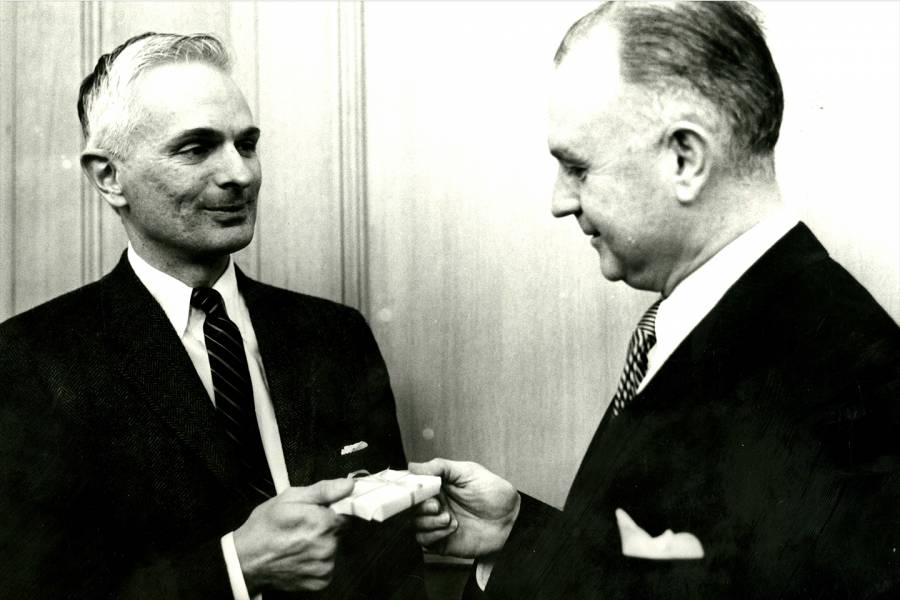Corbin Gwaltney, a 1943 graduate of Johns Hopkins University and a pioneering editor who founded Johns Hopkins Magazine, The Chronicle of Higher Education, and The Chronicle of Philanthropy, died Monday at his home in Potomac, Maryland. He was 97.
Gwaltney was born in Baltimore in 1922 and graduated from Hopkins in 1943. After a stint as a U.S. Army infantryman, he returned to Baltimore and went to work for Western Electric. At the same time, he played with an idea to transform the university's alumni magazine from "an unremarkable assemblage of campus reports and alumni notes to a publication with top-notch photography and in-depth features that would continue to instruct Hopkins graduates long after they had received their degrees," The Chronicle of Higher Education wrote in an article chronicling Gwaltney's career and accomplishments earlier this week.
The first issue of Johns Hopkins Magazine landed in readers' mailboxes in 1950, marking the birth of a new kind of alumni magazine. Published for the graduates, faculty, and friends of a leading university, it was conceived to give readers intellectual nourishment, in contrast to other alumni publications of the day.
Gwaltney earned praise from Time for creating "a model of lively thought," and Newsweek wrote approvingly of the magazine's "cerebral qualities." Show, the Magazine of the Arts, wrote, "Both the photographs and text are of a quality that many consumer magazines might well envy."
From the magazine's early days, Gwaltney made it clear that the publication would report honestly on the university. As a mentor to other young alumni magazine editors, he argued the virtues of editorial independence, contending that editors should be given the same sort of academic freedom afforded to university professors.
"I really truly loved Hopkins very much," he told Johns Hopkins Magazine for an article published in April 2000, "yet I tried to approach it as a journalist would, always asking the hard question."
Sue DePasquale, who authored that 2000 article about Gwaltney and served as editor of the magazine from 1994 to 2006, said Gwaltney's profound influence on the publication was palpable, even decades after his departure.
"From my earliest days with the magazine, and throughout my years as editor, I was aware of Corbin Gwaltney's visionary role in the world of alumni magazines, and I did my very best to honor his legacy," said DePasquale, now the editor of Hopkins Medicine magazine and consulting editor for several divisional magazines at the university. "In particular, I was guided by his admonition to ask the hard questions of our university, and to report honestly when the occasional bad news happened. Such editorial independence and honesty is not the rule among alumni magazines, but Corbin wisely recognized that our readers are smart people—and more apt to trust us and connect with Johns Hopkins if we take a 'warts and all' approach in our coverage."
More from DePasquale's April 2000 Johns Hopkins Magazine article on Gwaltney and the magazine's origins:
The year was 1949 and Gwaltney had a vision for a new kind of university magazine. A magazine that would serve up substantive stories about the people and the work at Johns Hopkins, with Life-quality photography. A magazine that would be a source of continuing education for alumni, rather than simply a repository of class notes, fundraising pitches, and campus news.
But before he could publish the first issue, he had to sell the idea to the university's powers-that-be.
So Gwaltney put together the dummy. In it, he included the idea for a photo-laden story on the university's Chesapeake Bay Institute, as well as an article on Hopkins's foray into television with the weekly Johns Hopkins Science Review program.
Provost P. Stewart Macaulay, a former newspaperman, and others liked what they saw, so they gave their alumnus carte blanche—and about $40,000 in annual funding, as Gwaltney remembers it—to produce nine issues a year.
Gwaltney set to work with new assistant editor Ellen Watson, a recent Wellesley grad who'd done reporting for the Baltimore Sun. Six months later, in April 1950, the first issue of Johns Hopkins Magazine landed in the mailboxes of the university's alumni.
As Gwaltney remembers it today, "President [Detlev] Bronk was absolutely livid. He hated it."
Bronk, it turns out, had envisioned a magazine more along the lines of the MIT Technology Review—highly technical and seriously scientific. Macaulay and others on the Magazine's editorial board successfully convinced Bronk to give the fledgling magazine a chance. Bronk did, and one year later, it was named the 1951 Robert Sibley Magazine of the Year—the best college or university magazine in the country. During Gwaltney's decade as editor, the Magazine would be similarly honored twice more, in 1956 and 1959.
The Johns Hopkins Magazine "changed the whole alumni publishing field, as one after another young editor, mentored largely by Corbin, would take over alumni publications" and implement a similar philosophy, says Ron Wolk, who joined the magazine's staff in 1958.
Gwaltney served as the magazine's editor until 1959, when he left to become the first full-time employee of the fledgling Editorial Projects for Education (later renamed Editorial Projects in Education). That endeavor eventually led to the creation of The Chronicle of Higher Education, which published its first issue in November 1966.
More than half a century later, The Chronicle remains the authoritative source for higher education news.
"Fiercely independent and at times mercurial, Gwaltney was a newspaperman to his core who combined a sophisticated devotion to language and a designer's love of fonts and photography as he built The Chronicles into the leading professional publications in their sectors," The Chronicle of Higher Education wrote. "He was active as the top editor well into his 70s, and he continued to speak longingly about sitting in the editor's chair until the end."
Gwaltney is survived by his wife, Pamela, chair of The Chronicle; two daughters, Jean Gwaltney and Margaret Gwaltney; a son, Thomas Gwaltney; five grandchildren; and one great-grandchild.
Posted in University News
Tagged in memoriam








